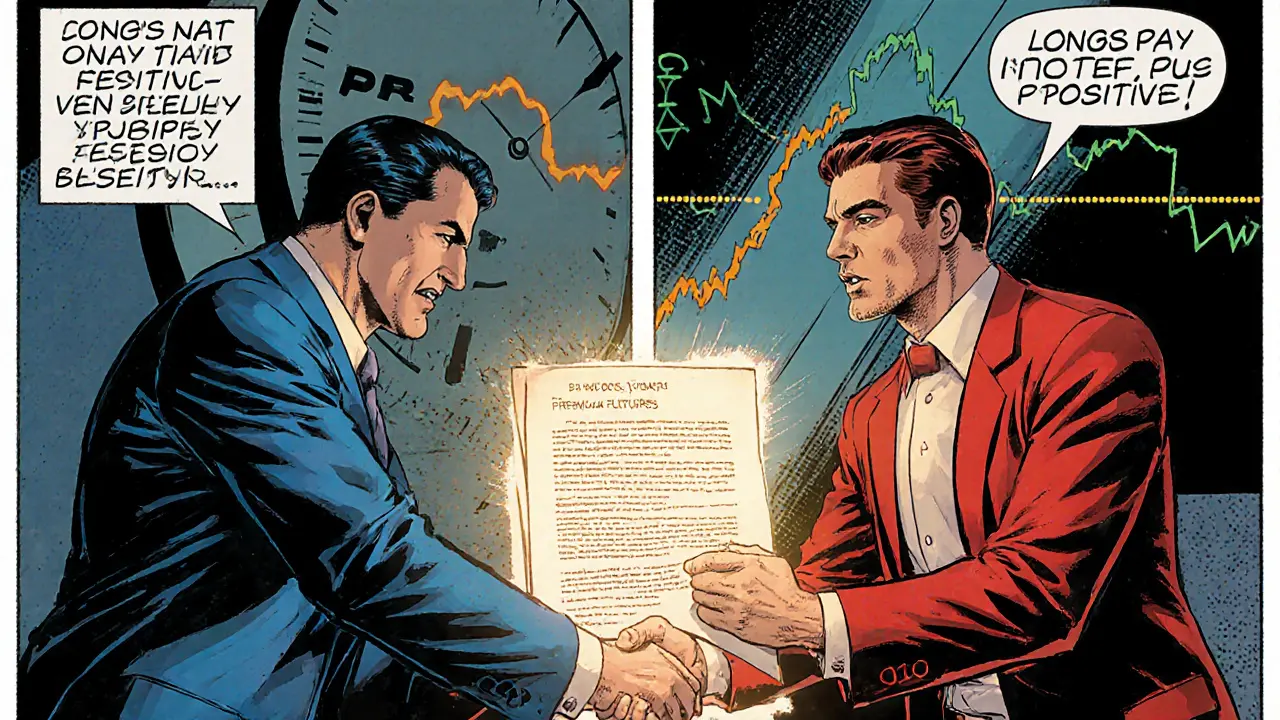
Funding Rate Calculator
Funding Impact Analysis
Enter values and click Calculate to see the impact of funding rates on your position.
Quick Takeaways
- Funding rates keep perpetual futures prices tethered to the spot market by swapping payments between longs and shorts.
- They are calculated every minute but settle typically every 8hours, using an interest component plus a premium index.
- Positive rates = longs pay shorts; negative rates = shorts pay longs.
- High positive rates can erode profits - a 0.1% 8‑hour rate equals roughly 1.1%permonth for longs.
- Common strategies: avoid costly funding, use negative rates as contrarian signals, or run cross‑exchange arbitrage.
What Are Funding Rates?
When you trade a perpetual futures contract, you never face an expiration date. That convenience comes with a hidden mechanism called the funding rate a periodic payment that balances long and short positions to keep the contract price in line with the underlying spot price. The idea first appeared on the BitMEX exchange in August2016 and has become the backbone of crypto‑derivatives markets.
Without funding, a perpetual contract could drift far above or below the spot market, creating arbitrage gaps and confusing price signals. By paying a small fee when the contract is overpriced (or receiving a fee when it’s underpriced), the market self‑corrects.
How Funding Rates Are Calculated
Most exchanges break the rate into two parts:
- Interest component: reflects the cost of capital for holding a position.
- Premium index: measures the spread between the perpetual price and the spot price the current market price of the underlying cryptocurrency.
Every minute the exchange updates the premium index, but the cumulative rate settles only at fixed intervals - most commonly every 8hours (00:00, 08:00, 16:00UTC). The formula varies by platform, yet the core concept stays the same:
Funding Rate = Interest Rate + Premium Index
For example, on 15June2024 Binance reported a BTC/USDT rate of -0.0156 (‑1.56% per 8‑hour period) when the spot price was $67,250 and the perpetual price $67,180.50, signaling a short‑biased market.

Why Funding Rates Matter to Traders
Think of funding as a hidden tax or subsidy that can dramatically affect your P&L. A positive rate of 0.1% every 8hours translates to about 1.1%monthly for long holders - enough to shave a few percent off a winning trade.
Conversely, a negative rate pays you for holding shorts, often indicating that the market is over‑leveraged on the long side. Experienced traders watch these swings to gauge sentiment. As BobbyOng of CoinGecko notes, extreme negative rates (<‑0.05% per 8hours) often hint at capitulation and potential mean‑reversion moves.
Practical Strategies Using Funding Rates
Below are three battle‑tested tactics that work across most major exchanges.
- Avoid costly funding: If the 8‑hour rate exceeds 0.075% (≈10%annualized), many traders reduce exposure or switch to a neutral‑rate market.
- Contrarian entry on negative rates: When rates dip below -0.05%, consider short positions or long‑short combos that profit from a potential rebound.
- Cross‑exchange arbitrage: Hold a long on an exchange with a negative rate and a short on one with a positive rate. The spread (e.g., +0.03% vs ‑0.02%) turns into almost risk‑free profit after funding settles.
Successful arbitrage requires low latency and reliable data feeds. Platforms like CoinGlass and Amberdata’s Funding Rate Forecast provide real‑time updates and predictive alerts.
Tools & Resources to Track Funding Rates
Even seasoned traders rely on dedicated dashboards. Here are the most popular options as of October2025:
- CoinGlass: aggregates rates from 30+ exchanges, updates every minute, offers custom alerts.
- Amberdata Funding Rate Forecast: predicts 4‑hour rates with 89% accuracy using on‑chain whale data.
- Bybit Funding Heatmap: visualizes expected rates 24hours ahead, useful for planning arbitrage windows.
- dYdX Adaptive Funding: automatically widens the neutral zone during high volatility, lowering unnecessary payments by ~37%.

Comparison of Funding Rate Mechanics Across Major Exchanges
| Exchange | Settlement Interval | Rate Calculation | Neutral Zone Width | API Availability |
|---|---|---|---|---|
| Binance | Every 8hours | Interest+Premium Index (15‑min average) | 0.01%± | REST & WebSocket |
| Bybit | Every 8hours (heatmap preview 24h) | Interest+Premium Index (1‑min updates) | 0.015%± | REST & WebSocket |
| BitMEX | Every 8hours | Interest+Premium Index (30‑min average) | 0.02%± | REST only |
Notice how Bybit’s heatmap gives a predictive edge, while BitMEX’s older averaging method can lag during rapid moves.
Common Pitfalls and How to Avoid Them
Even knowledgeable traders slip up. Here are the most frequent mistakes:
- Ignoring weekend spikes: Funding can swing sharply when liquidity thins on weekends; set alerts for absolute rate thresholds.
- Assuming rates are always small: During extreme market events (e.g., March2021 BTC bull run) rates hit 0.15% per 8hours - that’s a 16%annualized cost.
- Over‑leveraging on a single side: A high positive rate can quickly drain margin if the market reverses.
- Neglecting exchange‑specific documentation: Bybit’s guide scores 4.6/5 for clarity, while Bitfinex’s only 2.8/5 - poor docs can hide hidden fees.
Mitigate risk by using a funding‑rate checklist before entering any trade:
- Is the 8‑hour rate <0.05% for longs or >‑0.05% for shorts?
- Do I have a stop‑loss that accounts for funding‑related drawdown?
- Am I monitoring multiple exchanges for arbitrage opportunities?
Future Outlook: Where Funding Rates Are Headed
Machine‑learning‑driven funding mechanisms are gaining traction. dYdX’s adaptive model and Amberdata’s on‑chain‑aware “Smart Funding Rates” already improve prediction accuracy to ~89%. Gartner predicts that by 2026, 70% of major exchanges will use AI to dynamically adjust both the rate value and the settlement interval based on volatility metrics.
Regulators, however, are watching closely. The SEC’s proposed “Digital Commodities” framework could re‑classify certain perpetual contracts, forcing exchanges to redesign funding calculations. Until then, the core principle - swapping payments to align perpetual and spot prices - remains sound, having processed over $15trillion in volume since 2016 without systemic failure.
Frequently Asked Questions
How often do funding rates settle?
Most exchanges settle every 8hours (00:00, 08:00, 16:00UTC), though the underlying premium index updates every minute.
What happens if the funding rate is zero?
A zero rate means the perpetual price is essentially equal to the spot price; longs and shorts exchange no payment.
Can funding rates be manipulated?
Yes. Large traders (“whales”) can push the perpetual price to trigger favorable rates, as seen in the Nov2021 $1.2billion liquidation event on BitMEX.
Is funding rate arbitrage risk‑free?
It’s low‑risk but not risk‑free. Execution lag, funding‑rate changes, and transaction fees can erode the spread.
How can I protect my position from high funding costs?
Set a maximum acceptable rate (e.g., 0.075% per 8hours), use hedging contracts on a different exchange, or switch to a contract with a lower neutral‑zone width.






There are 19 Comments
Jacob Moore
Hey folks, if you’re diving into perpetual futures, understanding funding rates is the first step to keeping your P&L healthy. Think of the rate as a tiny “interest” that swaps between longs and shorts every 8 hours, keeping the contract price glued to the spot market. By tracking that number you can avoid surprising drain on your position or even capture a little extra on the side. Stay sharp, monitor the feed, and let the funding work for you rather than against you.
Hanna Regehr
The funding mechanism essentially aligns perpetual prices with the underlying spot, which helps prevent large arbitrage gaps. A positive rate means longs are paying shorts, while a negative rate flips that relationship. Keeping an eye on the rate over time can give you a clearer picture of market bias.
Ben Parker
Funding rates can feel like a hidden tax, but they’re actually a market‑level balancing act! 🚀💰 Keep checking the 8‑hour snapshots so you’re never caught off‑guard. 😊
Sanjay Lago
Yo, funding rates r like that annoying rent you gotta pay if you're holding a long when the market's bullish. If the rate go positive, you lose some cash each 8h, but a negative one actually pays u! So always peep the numbers before you lock in a position.
arnab nath
They don’t tell you, but the big exchanges tweak funding to push retail into liquidation cycles. Keep your eyes open.
Orlando Lucas
When you first encounter perpetual futures, the funding rate often appears as a minor footnote, yet it is the cornerstone of the contract’s price integrity. Fundamentally, the rate is a periodic cash flow that exchanges between traders holding opposing positions, ensuring the perpetual price does not stray far from the spot index. This exchange occurs every eight hours, a cadence chosen to balance responsiveness with operational simplicity. The calculation itself blends an interest rate component, reflecting the cost of capital, with a premium index, which measures the divergence between the perpetual and spot markets. In practice, a positive funding rate signals that longs are paying shorts, effectively rewarding the bearish side for providing liquidity. Conversely, a negative rate means shorts are compensating longs, indicating a market bias toward bullish sentiment. Because these rates can fluctuate dramatically during periods of high volatility, they act as both a signal and a cost, influencing trader behavior in subtle ways. For instance, a trader with a long position may decide to close early if a sustained positive rate begins to erode profit margins. On the other hand, savvy participants might deliberately seek out negative funding environments to earn a “carry” on short positions. Moreover, arbitrageurs exploit persistent rate differences across exchanges, moving capital to capture the spread between higher and lower funding environments. This activity, while profitable for the arbitrageur, also serves to compress funding disparities, contributing to market efficiency. It is essential to recognize that funding rates are not static; they react to shifts in open interest, order book depth, and broader market sentiment. Monitoring the rate trajectory alongside other indicators, such as open interest and volume, can provide a richer context for decision‑making. In summary, funding rates are more than a mechanical fee-they are a dynamic gauge of market equilibrium, a potential source of yield, and a factor that must be integrated into any robust perpetual futures strategy.
Philip Smart
Funding rates are the hidden tax on perpetual futures.
Manas Patil
From a risk‑management perspective, the funding rate functions as a contingent cash‑flow expense, directly impacting the carry component of your position’s total return. By incorporating the funding differential into your P&L attribution, you can more accurately assess the net basis versus the spot benchmark. Leveraging real‑time funding feeds alongside the premium index enables a multi‑factor model for signal generation.
Annie McCullough
Funding rates can be a secret weapon🤔 they let you profit from market bias without moving the price🚀
Carol Fisher
Our traders should master funding rates because it keeps our markets strong 🇺🇸💪. Ignoring it is like giving away profit to foreign platforms.
Melanie Birt
Make sure to log the funding rate every 8 hours and compare it against your position size. If the rate flips sign, reconsider your exposure because the cash flow direction will reverse. A simple spreadsheet can automate this tracking and save you headaches later. 😊
Lady Celeste
All that fluff is just jargon to hide the fact that most retail traders get burned.
Ethan Chambers
One must appreciate that the intricacies of funding dynamics transcend mere "fluff" and represent a sophisticated equilibrium mechanism, a nuance lost on the uninitiated.
gayle Smith
The drama of funding rates is that they can turn a quiet market into a battlefield of cash‑flow warfare. When the premium index spikes, the rate can swing like a pendulum, forcing traders into scramble mode. It’s the hidden catalyst behind many liquidations.
mark noopa
Look, the funding rate isn’t just some random number tossed in for fun – it’s the lifeblood of perpetual contracts, the invisible hand that nudges longs and shorts into a perpetual dance of give‑and‑take. 🌌 When the market is bullish, you’ll often see a positive funding rate, meaning the longs are essentially paying a rent to the shorts for the privilege of holding the upside. 🤷♂️ Conversely, a bearish sentiment flips the script and shorts pay the longs, creating a subtle incentive to bet against the crowd. This mechanism, dear reader, is designed to keep the perpetual price tethered to the spot, preventing wild deviations that would otherwise break the economics of the contract. Now, many novices look at a 0.01 % eight‑hour rate and think “meh, that’s nothing,” but over a month that compounds to roughly 1 % – a non‑trivial slice of your margin. 📉 Moreover, funding rates are not static; they respond to shifts in open interest, order‑book depth, and even exchange‑specific policies, making them a dynamic indicator of market sentiment. If you’re a scalper, you might chase periods of negative funding to earn a small carry on your shorts, while swing traders may avoid high‑positive rates that would gnaw away at profit. Arbitrageurs, on the other hand, hop between exchanges, exploiting discrepancies in funding to lock in risk‑free yield. 🤑 It’s a cat‑and‑mouse game where the “cat” is the exchange fees and the “mouse” is the trader’s ingenuity. Remember, the funding you pay or receive is settled in the quote asset, typically USDT, so it directly impacts your cash balance regardless of price movement. Therefore, a robust trading strategy should factor in funding forecasts, perhaps using historical patterns or on‑chain data to anticipate upcoming spikes. Finally, never ignore the social narrative – when news drives sentiment, funding can swing like a pendulum, turning a calm market into a funding frenzy overnight. So, keep your eyes on the rate, your spreadsheets updated, and your risk limits tight. 🌐
Rama Julianto
Don’t be a fool and ignore funding – it’s the sneaky fee that can wipe you out. Check the rate every 8h, adjust your size, and if it goes against you, cut the trade fast. Use a simple alert script to stay on top of it, otherwise you’ll regret it later.
Helen Fitzgerald
Hey everyone, just a quick reminder to add funding rate monitoring to your daily routine. A tiny spreadsheet or even a Telegram bot can keep you posted on any sudden changes. It’s a small habit that pays big dividends in the long run.
Scott Hall
Funding rates are basically the market’s way of saying “pay up” or “you’re welcome” every eight hours. Watching them gives you a pulse on who’s in control.
Jade Hibbert
Oh great, another hidden fee to love.
Write a comment
Your email address will not be published. Required fields are marked *